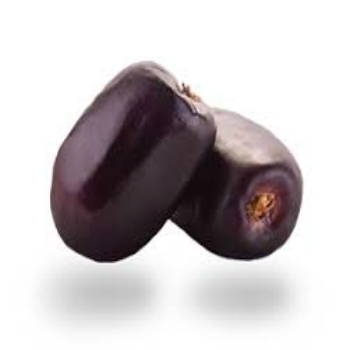IRANIAN MAZAFATI DATES
Rotab Mazafati Bam
Mazafati dates, also known as Kimia Dates and Bam dates (after the region in which the most delicious dates of this kind are grown), are one of the many different kinds of Iranian date fruit. They are perhaps the most popular, well-known variety of date; it is estimated that Mazafati dates account for 20% of Iran’s total export of dates. With a unique taste, they are considered to be one of the most delicious of all date varieties.
History: Mazafati date production primarily occurs in Bam city, Kerman province. This is the most place most associated with the production of high quality Mazafati dates. The Bam region has around 28,000 hectares of land dedicated to the harvesting Mazafati dates, 5,000 hectres of which is reserved for young palm trees.
Description: Mazafati dates are dark, soft, fleshy, sweet and succulent. They are a medium sized date, typically around 2.5-4.5cm, and have a relatively high moisture content of 32-35%. They are best consumed as fresh dates.
Grown in: Southern Iran (mainly in Bam, Jiroft, Kahnuj, Nikshahr Saravan, Haji Abad and Iranshahr).
Harvesting period: August – October. The Mazafati is fully ripe at the end of the date season.
Production: Mazafati dates are one major species of fresh date and have a huge annual yield. It is estimated that 120,000 tons of the Mazafati dates are harvested annually. Primarily, this variety of date is consumed in domestic markets, but due to increased production in recent years, steps have been taken towards exporting also. Typically, Mazafti dates are harvested in 3 phases. Quality may vary between a high quality date with a soft, thin texture and low quality date with a hard, dry texture. It is a low waste process – samples of waste Mazafati dates were actually found to taste just as good, if not better, and be of just as good, if not better, quality. Annually, Iran produces close to one million tons of date fruit. There are 400 different types, 50 of which are well known in international markets and are exported throughout the world. Mazafati date palms can stay in production for over 60 years.
Exportation and consumer markets: Some of the major importers of Mazafati dates include North European countries (England, Sweden, Norway, Denmark, and Germany), the Persian Gulf littoral states, the North American countries (especially Canada), East Asian countries and Australia. Iranians living abroad are one of the main consumer sources.
Shelf life and storage: 2 years at -5°C or 12 months at 0-5°C (this can be prolonged by wrapping the dates in cling film and/or plastic). Mazafati dates should be kept refrigerated. The main producers of the Mazafati date keep them in cold storage; however, drying out Mazafati dates to reduce moisture can help to eliminate the need for cold storage.
Uses: Direct consumption – snacking and table eating. Dry or soft Mazafati dates can be eaten in their raw form, or may be seeded and stuffed, or chopped for use in cereals, puddings, bread, cakes, cookies, ice cream and candy bars. Since production is so high, surplus Mazafati dates are made into cubes, paste, spread, powder (date sugar) jam, jelly, juice, syrup, vinegar and alcohol.
Nutritional content and health benefits: Like all other varieties of date fruit, the Mazafati date is loaded with essential nutrients, including – amongst others – vitamins (A, B, C and E), minerals, iron, potassium, magnesium, manganese, protein, fibre, carbohydrates and simple sugars. 100g of Mazafati dates contains approximately 1.1g of protein, 0.15g of fat, 74.97g carbohydrates, 6.7g of dietary fibre and 113g of sugar.
Regular consumption of Mazafati dates can help to boost energy levels, strengthen nerves, treat anaemia, increase memory and alertness, improve skin, promote good digestive and heart health, and prevent indigestion and constipation.
Seeds: Mazafati date seeds are made up of 7.7-9.7% oil and make up 5.6-14.2% of the date’s weight. They contain 7.17-9% moisture, 1.83-5.3% protein, 6.8-9.32% fat, 65.5% carbohydrates, 6.4-13.6% fibre and 0.89-1.57% ash, as well as sterols, estrone and an alkali-soluble polysaccharide. The fatty acids contained in the oil are 8% lauric, 4% myristic, 25% palmitic, 10% stearic, 45% oleic and 10% linoleic, as well as some caprylic and capric acid. Mazafati date seeds can be chemically-processed to yield oxalic acid at a rate of 65%. Additionally, Mazafati date seeds contain 6-8% of a yellow-green, non-drying oil substitute which can be used in cosmetic products such as soap. Other uses include burning to make charcoal, use in making necklaces, and using the oil within the raw material industry to produce detergents, shampoo, soap, laundry power etc.
Mazafati date seeds have strong antioxidant properties due to their high flavonoid and phenolic compounds. In many cultures, the Mazafati date seed is known as the ‘blessed’ seed due to its many supposed cures, including the ability to strengthen the immune system and fight infection, as well as act as an anti-bacterial and anti-inflammatory. These health benefits have been confirmed in scientific research conducted in recent years.







